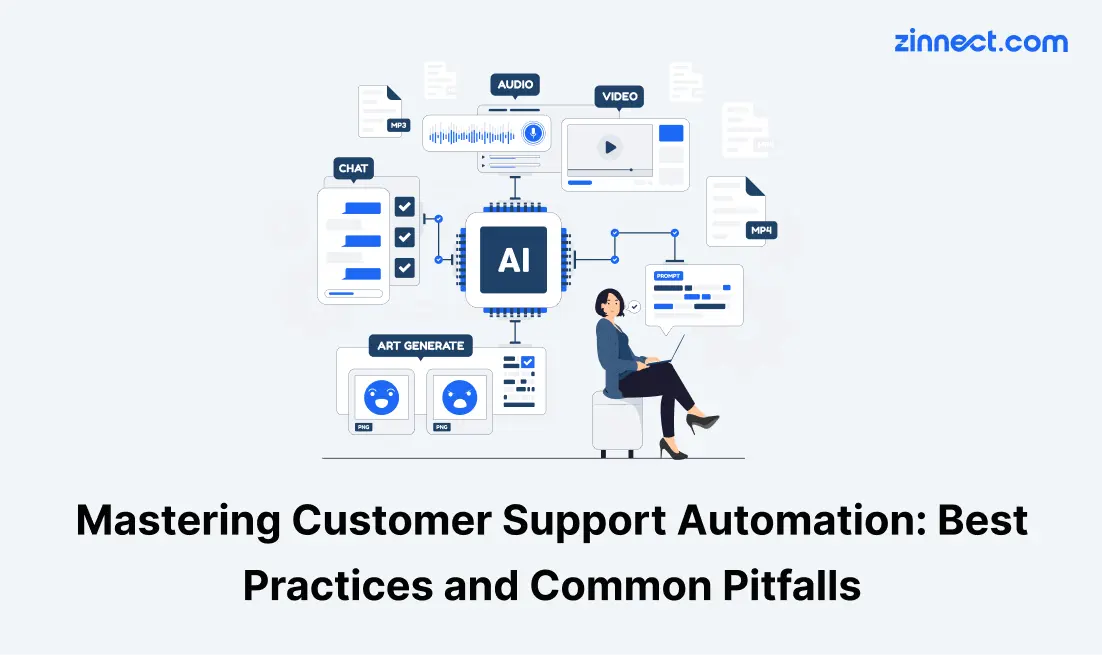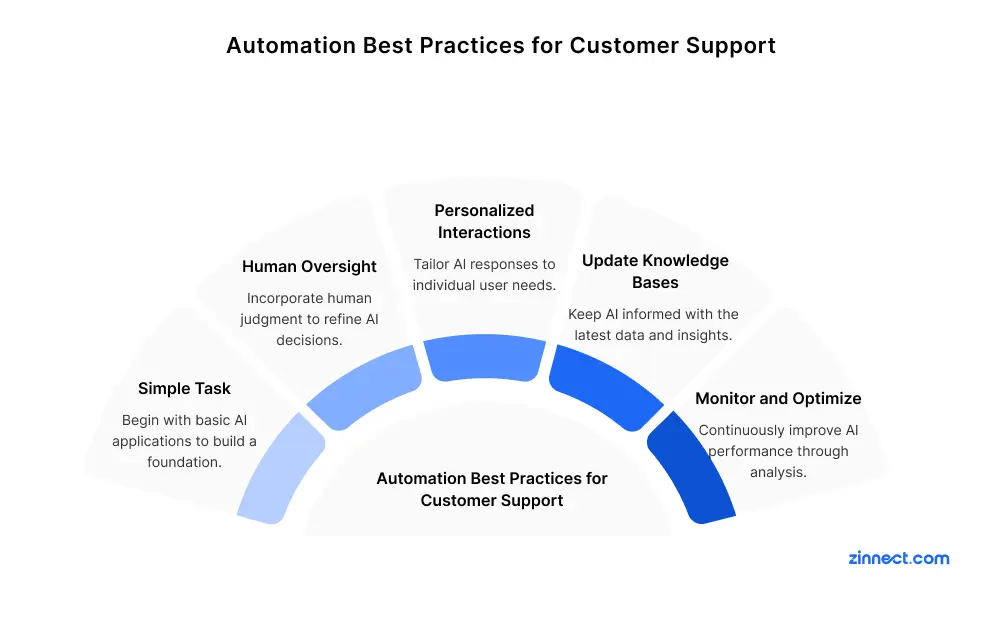Mastering Customer Support Automation: Best Practices and Common Pitfalls

This couldn’t be more true in the world of customer support. Automation isn’t a shortcut, it’s a force multiplier. If your processes are well-structured, automation can boost speed, consistency, and customer satisfaction. But if your foundation is shaky, automation may only highlight the inefficiencies, leading to frustrated users and support teams alike.
In today’s digital age, customer support automation has become a game-changer for businesses aiming to enhance efficiency and customer satisfaction. With rising customer expectations and the need for 24/7 assistance, companies (especially small and growing ones) are turning to automation to handle high volumes of queries without compromising on response quality or speed. From AI-powered chatbots to smart ticket routing systems, automation tools are helping teams scale their support while reducing operational costs.
However, while automation offers numerous benefits, it’s essential to implement it thoughtfully to avoid common pitfalls. Poor execution can result in impersonal interactions, frustrated customers, and even reputational damage. Striking the right balance between intelligent automation and human empathy is key. Businesses must remember that automation should enhance the customer experience, not replace the human touch where it’s most needed. By understanding the right strategies and being aware of what can go wrong, businesses can leverage automation to build trust, improve response times, and create support experiences that feel both fast and personal.

“Automation applied to an efficient operation will magnify the efficiency. Automation applied to an inefficient operation will magnify the inefficiency.”
What is Customer Support Automation?
Customer support automation involves using technology, such as chatbots, AI, and self-service portals, to handle customer inquiries and support tasks without constant human intervention. These tools are designed to simulate human-like conversations, guide users through common issues, and provide instant solutions based on pre-programmed knowledge or real-time data. From answering frequently asked questions to processing refunds or tracking orders, automated systems can resolve a wide range of customer needs efficiently and consistently.
This approach allows businesses to provide 24/7 support, ensuring that customers can get help at any time, regardless of time zones or staffing limitations. It also helps reduce response times significantly, which is crucial in maintaining customer satisfaction in today’s fast-paced digital environment. Additionally, automation frees up human agents to focus on more complex, high-value interactions, where empathy, decision-making, and critical thinking are essential. Ultimately, customer support automation doesn’t just streamline operations; it empowers businesses to scale support without sacrificing quality or human connection.
Automation Best Practices for Customer Support
Successfully implementing customer support automation isn’t just about choosing the latest tools, it’s about using them wisely to create meaningful and efficient customer experiences. Automation done right can help your business scale support operations, boost customer satisfaction, and reduce manual workload. But to unlock these benefits, it’s crucial to follow a thoughtful and strategic approach.
Below are key automation best practices that can guide your implementation journey, ensuring that your automated support feels seamless, helpful, and genuinely valuable to your customers.

Start with Simple Tasks:
Automate repetitive and straightforward tasks like FAQs, order tracking, and appointment scheduling. This ensures quick wins and minimizes disruption.
Integrate Human Oversight:
While automation handles routine queries, ensure that complex or sensitive issues can be escalated to human agents seamlessly. This hybrid approach maintains a personal touch where necessary.
Personalize Interactions:
Use AI to tailor responses based on customer data, preferences, and history. Personalized interactions can significantly enhance customer satisfaction.
Regularly Update Knowledge Bases:
Ensure that your automated systems have access to up-to-date information. Regularly review and update FAQs and support articles to maintain accuracy.
Monitor and Optimize:
Continuously track the performance of your automated systems. Use analytics to identify areas for improvement and adjust accordingly.
Common Pitfalls to Avoid
Despite the many advantages of customer support automation, there are several pitfalls that businesses, especially small and medium enterprises, should be wary of. Automation is not a set-it-and-forget-it solution. Without thoughtful planning, regular updates, and a clear understanding of your customers’ needs, it can lead to more harm than good.
Below are some of the most common mistakes businesses make when implementing customer support automation, and how you can avoid them.
No Escalation Path to Humans:
Automation is great, until it isn’t. One of the biggest frustrations customers face is being stuck in a loop of scripted responses when their issue requires human intervention. Always design your system with clear, timely escalation routes to live agents.
Inaccurate or Outdated Data:
Automated systems rely heavily on structured data. If the data feeding into your system is inaccurate, incomplete, or outdated, the automation will only amplify these errors. Regular data audits and validation are essential.
Over-Indexing on Efficiency, Not Resolution:
Speed is important, but resolution is what customers remember. Over-prioritizing fast response times can lead to half-baked solutions or irrelevant answers that frustrate users and erode trust.
Treating Automation as a One-Time Setup:
Automation isn’t a plug-and-play tool. Customer behavior, products, and market expectations evolve, and so should your system. Without regular tuning and iteration, even the smartest automation becomes obsolete.
Failing to Personalize Beyond the Basics:
Generic greetings and name insertions aren’t enough. If your automation doesn’t adapt to user context, such as recent purchases, past issues, or browsing behavior. It risks sounding robotic and disconnected.
Final Thoughts
Customer support automation, when implemented thoughtfully and strategically, can be a powerful asset for businesses of all sizes. It not only enhances operational efficiency by streamlining repetitive tasks but also improves the overall customer experience by offering faster, more consistent, and round-the-clock support. In a competitive landscape where customer expectations are constantly evolving, automation can help businesses stay agile, responsive, and resource-efficient.
However, the key lies in striking the right balance. By adhering to proven automation best practices, such as starting small, prioritizing human-AI collaboration, and continuously refining your systems, and by steering clear of common customer service pitfalls, businesses can unlock the full potential of automation. The goal isn’t to replace human agents, but to empower them and your customers with smarter, faster solutions.
For a deeper take on Scaling Customer Support with AI, click here to read our extensive article.
Explore our AI Customer Support Solutions and discover how Zinnect can help you deliver seamless, intelligent support that grows with your business.
Frequently Asked Questions
Yes, automation can be tailored to fit businesses of all sizes. Starting with simple automated responses can free up resources and improve efficiency.
No, automation is designed to handle routine tasks, allowing human agents to focus on more complex and nuanced customer interactions.
Implement robust data protection measures, comply with relevant regulations, and regularly audit your systems to ensure customer data is handled securely.
Provide options for customers to easily reach human agents when needed. A hybrid approach ensures that customer preferences are respected.
Use analytics to track key performance indicators such as response times, resolution rates, and customer satisfaction scores. Regularly review these metrics to assess and improve your automation strategy.